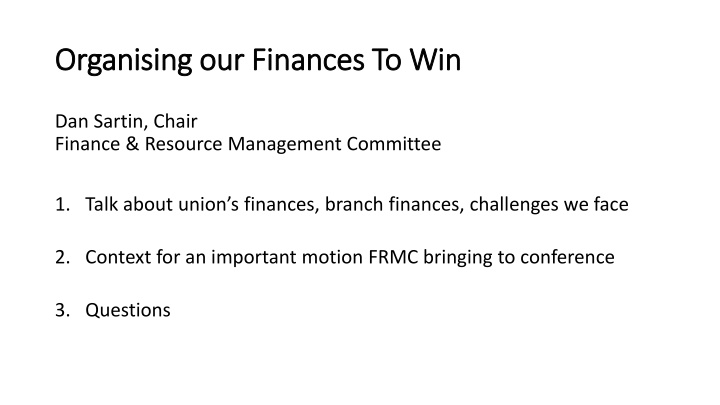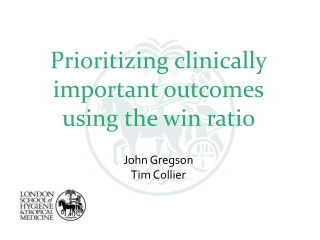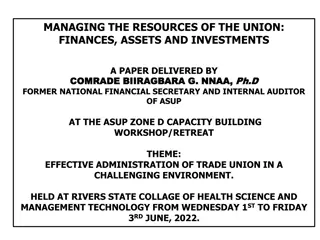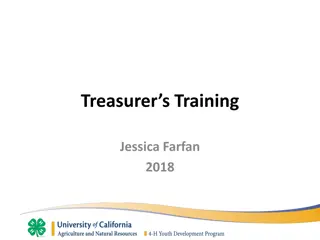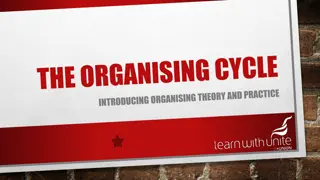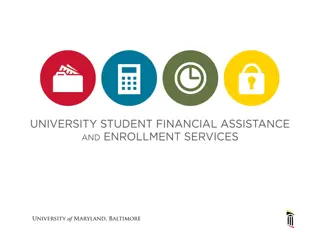Organising Our Finances to Win: Challenges and Strategies
In this discussion, explore the financial landscape of the union, branch finances, and the challenges faced in managing finances effectively. Dive into the context of a crucial motion brought to conference by the Finance & Resource Management Committee (FRMC) and address questions surrounding the topic. Delve into the volatile financial environment, impact of surpluses and inflation, budget deficits, cost pressures, investments, and support initiatives to ensure financial stability and organizational success.
Download Presentation

Please find below an Image/Link to download the presentation.
The content on the website is provided AS IS for your information and personal use only. It may not be sold, licensed, or shared on other websites without obtaining consent from the author.If you encounter any issues during the download, it is possible that the publisher has removed the file from their server.
You are allowed to download the files provided on this website for personal or commercial use, subject to the condition that they are used lawfully. All files are the property of their respective owners.
The content on the website is provided AS IS for your information and personal use only. It may not be sold, licensed, or shared on other websites without obtaining consent from the author.
E N D
Presentation Transcript
Organising our Finances To Win Organising our Finances To Win Dan Sartin, Chair Finance & Resource Management Committee 1. Talk about union s finances, branch finances, challenges we face 2. Context for an important motion FRMC bringing to conference 3. Questions
Introduction Branch Secretary Large branch; 450 employers Treasurer: works in Finance! Expenditure 2022 was circa 250K Employ branch staff on range of contracts Concerned with branch funding since 2013 NEC since 2017 Chair FRMC since June 2021
FRMC in 2022 and beyond Volatile environment Large Covid-19 surpluses, 2020 & 21 Rampant inflation 2022 & 2023: impact on UNISON as well as members National operating deficit of 8.7 million in 2022 12 of last 16 years: lost membership (leavers exceeding joiners) 2022: subs income on budget but 2.5 million less than in 2021 Staff costs growing proportionately (static or reducing membership income whilst staff costs grow with cost of living pay rises)
Unanticipated cost pressures Larger projected budget deficit for 2023 than acceptable U-magazine (4 to 1 save 2.4 million) UIA insurance and UNISONdirect There for You (additional 0.25 million) Pension Scheme ( 6.2 million) Staffing cost of living pay rise
Invest to save, invest to organise UNISON Centre review project and regional office Digital, 4 million over three years BSOF underway (2% of subs income, quadrupled)
Invest to support Review of allowances: overnight subsistence rates Doubled strike pay Industrial Action Fund: Branches 13.4 million National 19.7 million is that big enough? Income 2.6 million ( 1.3 million from national union) Total expenditure: 3.8 million (net deficit of 1.2 million) 1.4 million on printing ballots, 2.4 million on strike pay
Scrutiny BDS supplier Annual forward plan of contracts UNISON Centre review
Branches 827 branches 617 (75%) funded at 20% (reduced from 21% due to high reserves) 148 of 827 received top-up retention increments (18%) Agreed new funding formula in 2021 in use for less than 1 in 5 Branch reserves growing again: 62.4 million in 2022 Is this sensible? Would you design a system like this from scratch to meet member and branch needs? What about the current crisis facing our members?
Organising our Finances To Win Organising our Finances To Win Building UNISON s capacity for effective industrial action Building UNISON s capacity for effective industrial action Context Cost of Living crisis, after decade of austerity We struggle to turn members anger into effective strike action Often fail: see NHS ballots (260 of 268), LG consultative 2022 14% Organising approach is not embedded yet, NW are the pioneers but BSOF is early days Failure leads to a risk of losing members: instability for the whole union Need a whole union approach to resolving: including addressing anomalies in Finances
Unions reserves are part of the solution Covid-19 years 2020 and 2021: Branch reserves above 20.40 per member (or 11,200 for branches with less than 500 members) grew by 12,665,000 in two years. A similar thing happened in our national union: across the two Covid years, central reserves grew by 17,350,000. This provides a unique opportunity for investment However, not all Reserves are accessible Propose only to use excess branch general reserves i.e. cash in bank (not branch IAF or Property) Propose only to use excess cash in bank Reserves of central union (not assets, or ringfenced investments) Use 5.125 million from each ( 10.25 million)
Why? To invest in strike capacity & effectiveness: providing additional resources to enable the national Strategic Organising Unit and twelve regions to develop dedicated disputes organising capacity; delivering a union-wide, mandatory strike ready training programme over the next 12 months; supporting additional capital investment in technological systems to get out the vote e.g. expanding the Movement system; improving the accuracy of the membership system including continuous, pro-active cleansing and checking of member and employer records; significantly increasing the national Industrial Action Fund to support our members when they need to take action.
Sound investment for the growth of our union and its income better return than historically-low interest rates? Achieve our core objectives: the defence of members pay, terms and conditions. Fewer than 1 in 4 of our branches would be asked to make a contribution to these plans and investments, alongside the contribution from the national reserves. Only those branches with very highest reserves. Branches contributing would still be left with a minimum of 113 per member in their general reserves, or a minimum of 11,200 for branches with fewer than 501 members. (Reserves regulator is 12 per member.)
113 is more than enough for a rainy day or unexpected expenditure, and far more than the majority of branches feel they need to keep in reserves. Branches do not need 200/ 250 per member in Reserves; there is no need we have Section C funding for emergencies; if we need such high Reserves, why were they not used during 2010+ when our members have faced a continuous emergency? If we didn t use them then, when would we use them? The organising agenda does not sit easily alongside a culture of ever- growing, inactive resources. It makes no sense. Ultimately, we want to build our union, grow our union, make it more successful and powerful, so it can shape workplaces and our society. We don t do that by locking resources away.
The wider context This is part of a wider programme for systematic change and improvement of our union The 2021-23 NEC has also: oa review of Staffing roles and structures massively important; oa review of UNISON Centre; oa review of Comms M1; (unsatisfactory progress) oa review of the Legal services contract; (unsatisfactory progress) oPlus, we should return to the Branch Funding Formula over the next 2 years, 2023-25: is it working for branches? oThe finances of the union need rational approach. Our union needs to change. Our programme will grow our union. M84 will grow UNISON.
